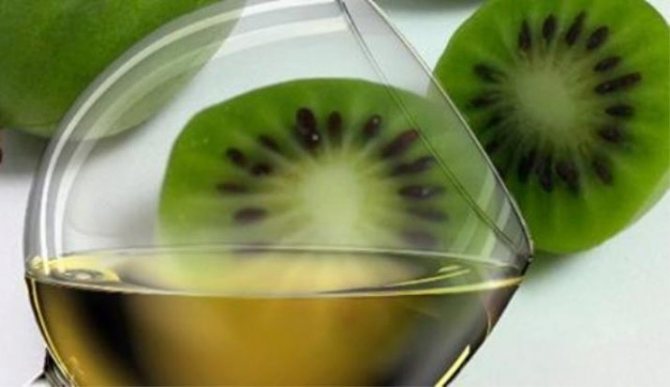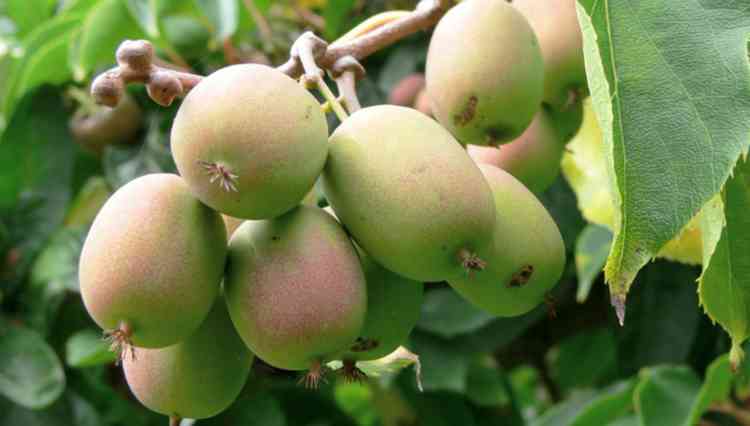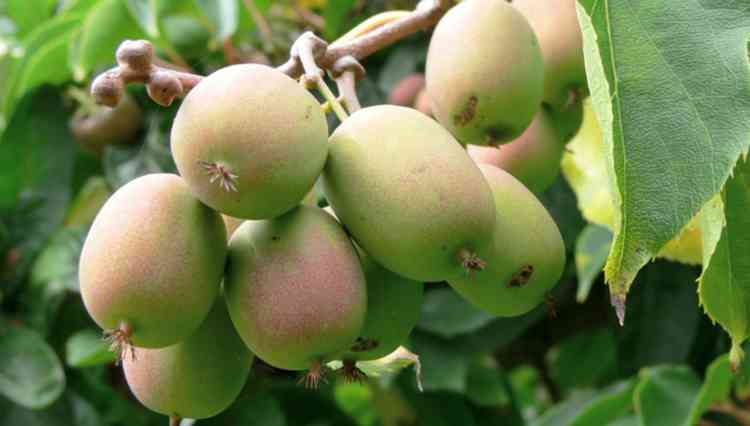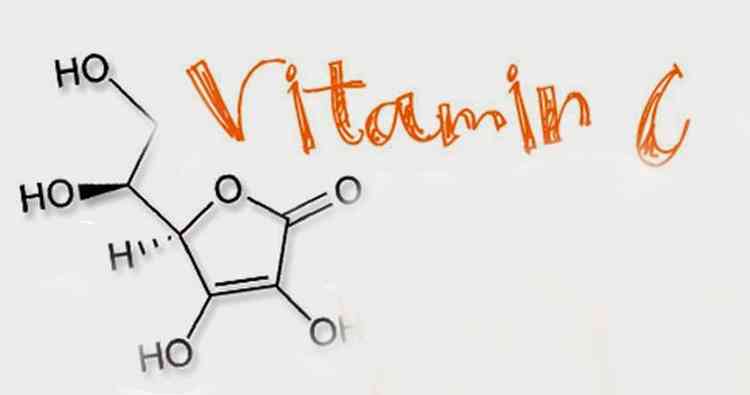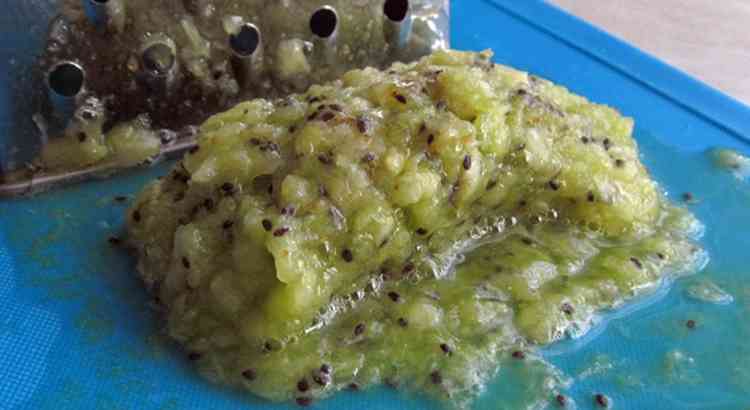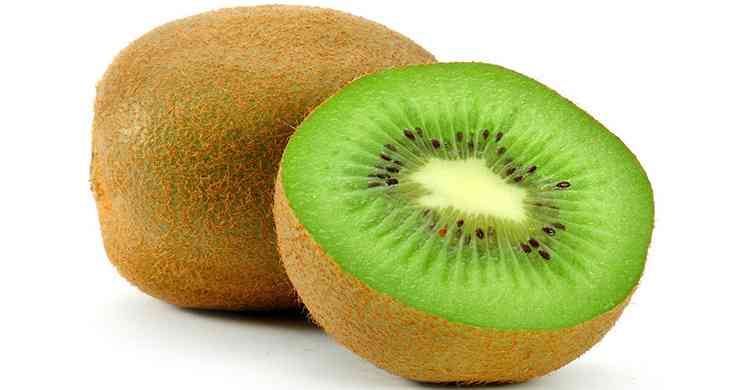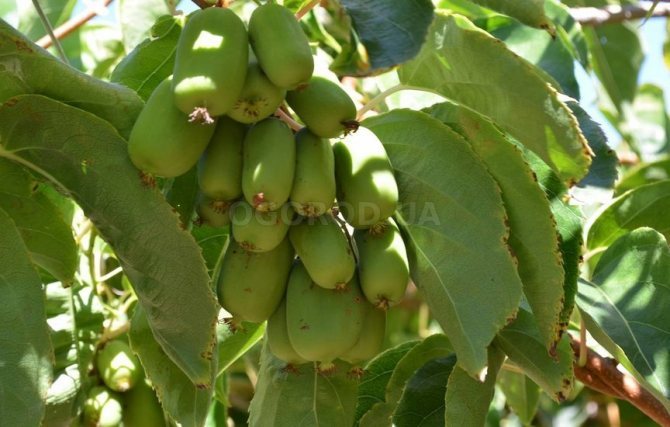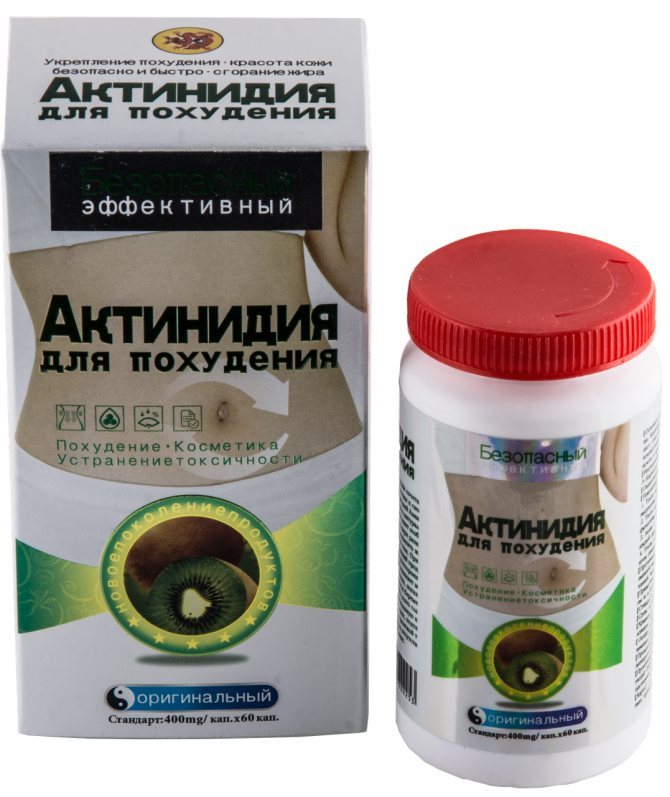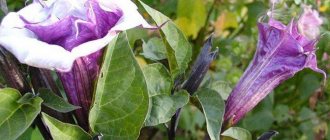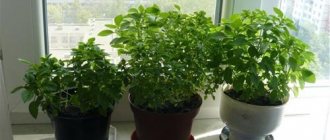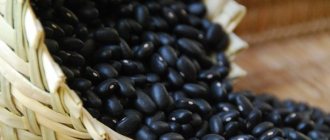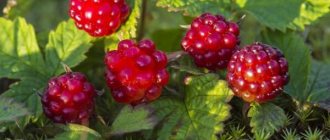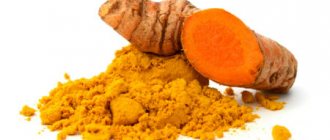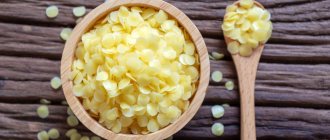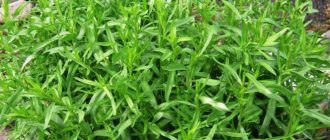Actinidia belong to the genus of lianas, their stems are woody, the foliage is rich green with small teeth, their outer part is smooth, and the lower part is covered with small villi. The shape of the leaves is similar to small hearts.
The flowers of this plant are collected in inflorescences, their color can be either white or cream, but they have no aroma. Fruits in shape and color may differ from each other depending on the variety of actinidia, most often they have a rich brown or bright green color.
Actinidia - photo, description
A beautiful liana with large simple leaves and small denticles at the edges, quite tall, with beautiful fragrant flowers and tasty fruits.
Actinidia is a perennial, from the genus of lianas, its trunks are similar to woody stems. There are villi on the underside of the leaves.
The flowers are cream or white, depending on the variety, they are of different shapes and colors.
There are about 30 plant species, of which the four most common plant species are cultivated by humans:
- Actinidia kolomikta, which is called "Amur gooseberry". Its berries are green and about three centimeters in size. The pulp is sweet and fragrant to the taste and actually resembles a gooseberry.
- Actinidia Chinese is well known to all of us under the name "kiwi". We all liked the delicate pulp of kiwi for its juiciness and wonderful taste, and we also liked the healthy qualities - kiwi has become a very popular fruit in our country.
- Actinidia arguta, or pungent actinidia, has the largest fruits, sweet taste, and aroma slightly reminiscent of pineapple.
- Actinidia is polygamous - it has many other names: nosed, sharp-fruited or polygamous. It is considered not edible due to its specific taste. It is grown as an original ornamental plant that can decorate the garden.
Botanical characteristic
Woody perennial climbing vines of various sizes. Distributed in the wild and in culture.
The leaves are alternate, simple, serrate. The flowers are correct, collected in brushes, fragrant. Blooms from May to July, bears fruit until October. The fruit is a berry with numerous seeds, edible, aromatic.
There are several types. The most common are:
- Actinidia acute - A. arguta Planch. Up to 20 m high, light brown bark. Young shoots are smooth in longitudinal lenticels. Leaves from round to oblong-ovate, with a wedge-shaped sharp base, finely toothed along the edge, shiny above, glabrous. The flowers are greenish, the fruits are dark green, laterally flattened, from spherical to cylindrical.
- Actinidia kolomikta - A. kolomikta Maxim. Liana up to 15 m with reddish-brown bark, when young in light small lenticels, old flaky, leaves are thin, dull, oval-elliptical with a heart-shaped base, sharp-serrated, pubescent along the veins, on the eve of flowering, the ends of the leaves turn white, during the formation of fruits - turn pink, later turn crimson. The flowers are white. Fruits are roundish light green with oblong stripes.
- Actinidia polygamous - A. polygama Mig. Up to 5 m in height with reddish-brown bark, in rare large light lenticels. Leaves are oval-pointed, serrate, glaucous, with bristly hairs on both sides. Flowers are yellowish.Fruits are light brown, cylindrical, with a conical nose.
Related article: Lush carnation - useful properties, description
Actinidia - beneficial properties
Nature is wise, she endowed the vine with the most valuable healing properties as a gift to man. They can only compete with a plant, sea buckthorn or rose hip.
First of all, the impressive amount of vitamin C will please, add here vitamins A and P. The content of vitamin C increases as the fruit ripens.
The fruits of the plant contain natural water, starch, reducing sugars, fiber and pectin, trace elements and minerals, sucrose, organic substances and dyes are fully represented. Also found tannins and cardiac glycosides. You will find essential oils in the seeds.
In folk medicine, berries are used as a sedative, analgesic, expectorant, hemostatic and tonic.

Due to the healing effect, in the absence of contraindications, the plant is used for:
- Diseases of the digestive system.
- Stomach neurosis.
- Tsinge.
- Anemia.
- Whooping cough.
- Chronic constipation.
- Lung disease.
- Bronchitis.
- Tuberculosis.
- Rheumatism.
- Worms.
- Frequent headaches.
- Dizziness.
In addition, the berries are involved in metabolic processes, regulating them, eliminate vitamin deficiency, a decoction of the plant's fruits helps with caries.
Jam
This particular product, according to most professionals, is the most valuable. You need to start by rubbing the fruits with sugar (its amount is exactly 60%). The sugar should be completely dissolved. Raw jam can be left at room temperature for up to 7 months. This method of conservation allows you to save 100% of ascorbic acid.
It must be remembered that at a higher temperature, fermentation temporarily begins (stops when cooled).
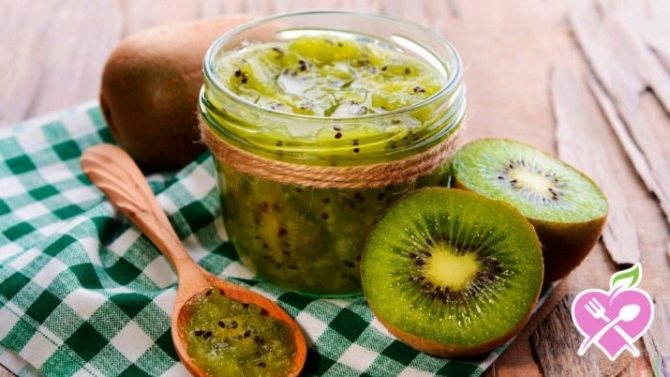

Folk recipes from medicinal berries
For medicinal purposes, actinidia uses the properties of the berries, bark, roots and leaves of the plant. Traditional healers have collected many recipes that can be used to help yourself with various ailments. I will introduce you to the correct preparation of a decoction, infusion, ointment,
Infusion of the leaves and flowers of actinidia
Herbalists infusion treat diseases of the joints, helps with gout, radiculitis, relieve the symptoms of angina pectoris.
- Pour a glass of boiling water with 20 gr. dry or fresh leaves or flowers of the plant. Then hold it in a water bath for 15 minutes and cool. If there are no other indications, drink a third of a glass of actinidia leaves three times a day.
Berry infusion recipe
It is taken as a fortifying agent with low immunity, after diseases, with impaired blood circulation in the brain.
- A glass of boiling water is taken on a large spoonful of bush berries. After a little infusion, take 100 ml. twice a day.
Infusion of actinidia
This remedy is taken for problems with the stomach or intestines, metabolic disorders, as well as anemia.
- To prepare a decoction of berries, take about a liter of boiling water for 2 large spoons. Brew in a thermos and leave overnight.
How to make a decoction from the bark
- 20 gr. chop the bark and pour a glass of boiled water. Next, you should hold the infusion in a water bath (half an hour is enough) and cool. Drink the filtered broth immediately after meals, 2 large spoons.
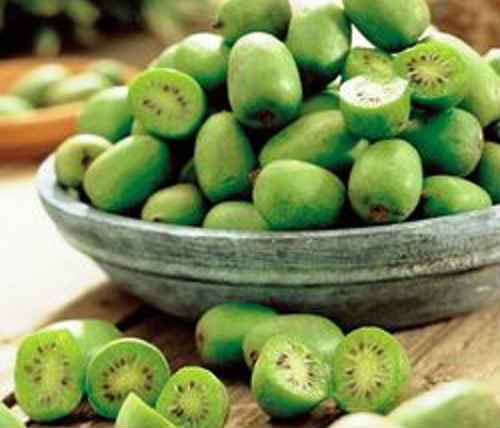

Infusion of roots
An infusion of plant roots is made for rinsing stomatitis. Infusion of roots will help with inflammation of the gums. For inflammatory diseases of the female genital area, herbalists advise doing douching and lotions. A decoction from the roots perfectly relieves joint pain.
- To prepare the infusion of the roots, they must first be peeled, cut and boiled over. In a water bath, the product lasts so long to get a concentrated strong infusion.
Concentrated infusion of berries
For the treatment of oncological diseases, in addition to the doctor's recommendations, a concentrated infusion of berries is used. The berries of the plant contain a rare vitamin Q, which inhibits metastases and the growth of cancer cells. The infusion is taken in small doses immediately after meals. It can be made in the same way as a concentrated infusion of roots.
Actinidia ointment
Fruit ointment is used externally as a healing remedy for recovery from fractures - intended for massage.
- To prepare the ointment, take the berries of the bitter varieties of the plant, for example, the polygamous one. Mash the berries and mix them with any fatty base (lard).
Cooking use
The pleasant taste of actinidia, reminiscent of gooseberries, allows it to be used in the preparation of many dessert dishes:
- fruit salad;
- jam;
- syrup;
- marmalade;
- wine;
- rubbed with sugar;
- dried (for medicinal purposes and for cooking compote);
- filling for baked goods.
Actinidia look beautiful as a cake decoration. The bouquet of flavors inherent in the fruit makes them a welcome addition to the preparation of meat and fish.
The healing properties of actinidia
Due to its qualities, berries have a pronounced healing effect.
- High pressure. Eat a few berries daily, which are high in potassium, which is good for your heart.
- Cold. Drink fresh juice or a decoction of the fruits, and you will recover faster by filling the body with vitamins C.
- Help with indigestion, heaviness after eating. Relieve heartburn and belching. The enzymes contained in the plant, which stimulate digestion, will heal from unpleasant sensations. In addition, the fruit contains actinidin, which contributes to the good digestion of meat.
- For constipation, eat the fresh fruits of the plant, they act as a mild laxative.
- Angina pectoris. Prepare an infusion of the leaves and flowers of the plant. Drink 1/3 cup after meals.
- Cerebral circulation disorder. Saddle the berry broth, drink 100 ml. twice a day.
- For wounds that do not heal for a long time, apply lotions from fresh juice.
Alternative method of drying
This recipe uses 1 kg of berries and 0.3 kg of sugar. For work, you need thoroughly ripe, but not overripe (this is important) berries. They are washed and dried thoroughly. Leave in a sugar-filled form for 1 day. Then the syrup is boiled using 200 ml of water. The prepared syrup is poured over the berries. The whole mixture is boiled over low heat for a maximum of 5 minutes. The fruits are pulled out with a slotted spoon and laid out on a baking sheet. This baking sheet is placed in the oven. The berries are dried for 15 minutes at 80 degrees, then 30 minutes at 70, and finally 180 minutes at 30 degrees.
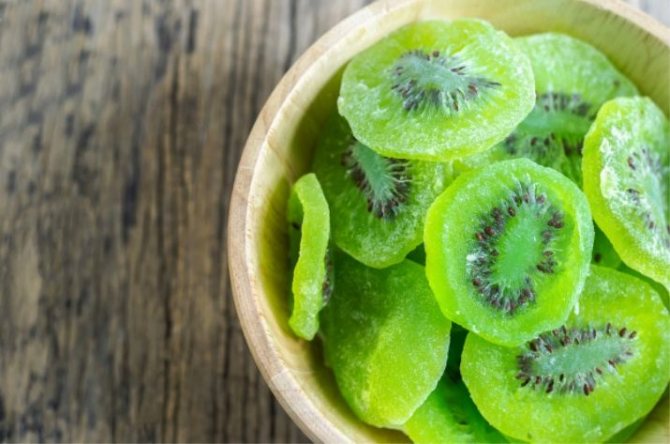

Actinidia berry juice
Fresh juice made from actinidia berries has a wound healing and regenerating effect. It is used externally to treat wounds that do not heal for a long time, wet eczema. Lotions that do an excellent job with the problem can be kept for no more than two hours.
It will help strengthen the immune system, with vitamin deficiency, is suitable for strengthening the body and improving appetite. Herbalists advise to dilute the juice with water when drinking.
The juice has contraindications:
- Gastritis with high acidity and ulcerative damage to the gastrointestinal tract.
- Kidney disease.
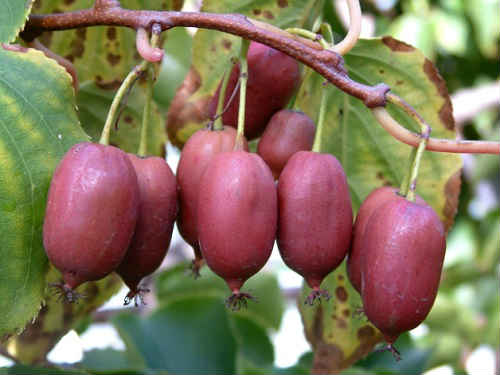

Drying
This method of harvesting for the winter is used only for small fruits. They must be washed and dried. The berries are spread in a soda solution. For its preparation, 0.03 kg of soda is used per 1 liter of pure boiled water. After aging in a soda solution, actinidia on a baking sheet is sent to the oven, heated to 70 degrees. The fruits will be ready in 2-3 hours.


Contraindications for use
The beneficial properties of actinidia have a downside - contraindications for use, and you should not neglect them if you value your health.
- It is strictly forbidden to use funds on the skeleton of the plant in case of venous disease, thrombophlebitis, poor blood clotting. By the way, if you have thick bloodthen read my tips for liquefying it.
- Do not get carried away by uncontrolled consumption of the fruits of the plant, this can cause intestinal upset - however, it goes away by itself if you stop eating the fruits.
- If this is your first time taking medications or trying berries, then do it carefully - the plant can cause allergies.
Drink
A tasty juice is also prepared from actinidia. To do this, the collected berries are left in a cool place for 24 hours, the juice is squeezed out, the liquid is heated in an enamel bowl to 70-80 degrees, the juice is poured into sterilized jars, these jars are sealed and left for storage.
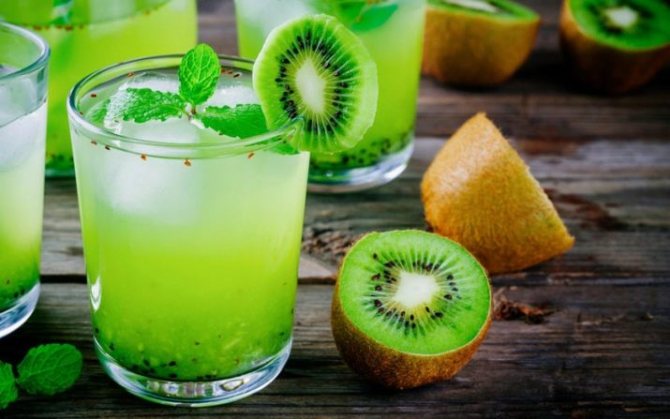

Many people really like actinidia jelly. To make it, the fruits are gently kneaded in enamel or plastic containers. To do this, use a wooden pestle. After that, the berry mass is covered with sugar.
Its amount should be the same as the number of berries.
Next, you need to thoroughly mix the products, transfer to another container, boil over low heat until fully cooked, put in glass jars.
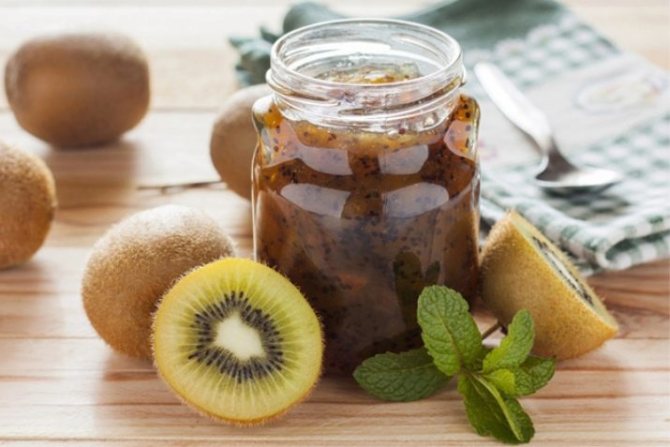

What can be cooked from actinidia
You can cook anything that is prepared from any berry. If there are no contraindications, then they are eaten fresh, canned in compote, jam, jam, marshmallow, jelly, make jelly and syrup.
The fruits contain a very successful combination of ascorbic acid and polyphenols (sugar), allowing you to benefit from both fresh fruits and from frozen or dried ones - they are perfectly preserved.
And you can also do wonderful kiwi mask, recipes and your skin will be very grateful to you for it.
How to prepare actinidia
For treatment, herbalists are advised to collect the leaves, berries, flowers or bark of the vine.
This is done in the usual way. The flowers are plucked and dried during the flowering period, which is May - June. Ripe fruits appear in July and end only in October.
Experienced gardeners do not advise putting actinidia in metal dishes, as this leads to the rapid destruction of vitamins, especially C, the benefits of which for the body are difficult to overestimate. Glassware is great for storing berries. It is better to choose a dark place, without active sunlight, in order to also prevent the destruction of valuable substances.
I found a video about actinidia for you, I hope that the information will be of interest to you. Be healthy! With love ... Galina Nekrasova.
Appearance and place of growth
Actinidia is a vine-like vine. I often use it as a decorative element. A long, flexible, tree-like branch up to 25 meters long braids objects counterclockwise. There are a lot of leaves, they are wrinkled in the process of plant growth, changing color from bronze to white, and then bright red or violet-red. Large white flowers grow on drooping pedicels. The oval-shaped fruits reach 2.5 centimeters in length. They are soft, taste good and have a strong smell. There are many small seeds inside. The smell of actinidia is strong, but pleasant, a bit like the smell of jasmine.
Actinidia naturally grows in the Himalayas, in Southeast Asia, Sakhalin and the Kuril Islands, in Primorye and China, South Africa and New Zealand. Such widespread distribution is possible due to the fact that some types of actinidia can withstand temperatures down to -40 ° C. In nature, the length of the branches can reach 100 meters, turning the plant into a small bush up to 3 meters in height.
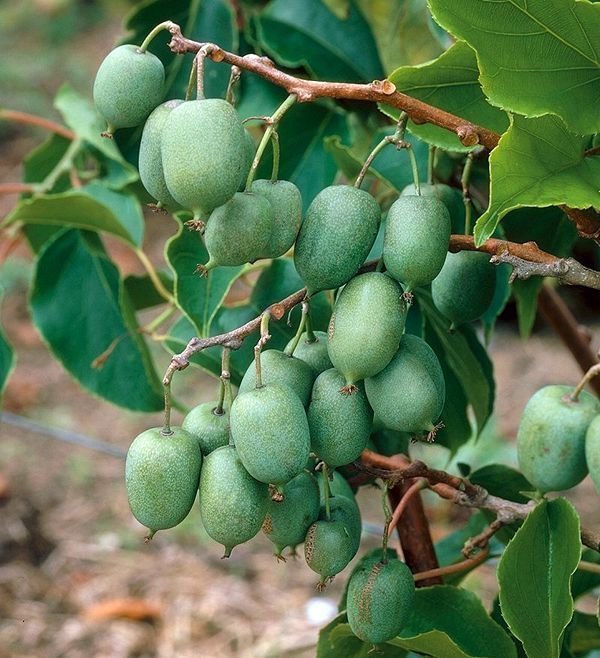

Compote
To make it, well-washed berries are placed in an ordinary glass jar. They are immediately poured with heated syrup. For its preparation, 0.3 kg of granulated sugar is put on 1 liter of water.Pasteurization under the lids lasts ¼ hour. Ready-made compote is easiest to store in dark, cool rooms.


To do it, they usually take:
The fruits are heated over low heat until juice appears. As soon as it starts to come out, the berries are crushed with a pusher from a tree. After crushing, lemons are poured into the same container (they are pre-cut into smaller pieces). Cooking should go to full readiness, while being guided by taste. Stir continuously while the jam is cooking.


To prepare this drink, you need to take 1 kg of ripe berries and chop them. This gruel is left in a container where it can ferment. To ferment faster and more efficiently, add 0.3 kg of sugar and 3 liters of water. All this mixture is kept in a dark corner for 10 days. Shake the bottle once a day. On day 10, add an additional 0.3 kg of sugar. On the 20th, the addition is repeated. Fermentation is usually completed within a month. The finished wine is poured into smaller, clean bottles. They are carefully corked and placed in the cold.
